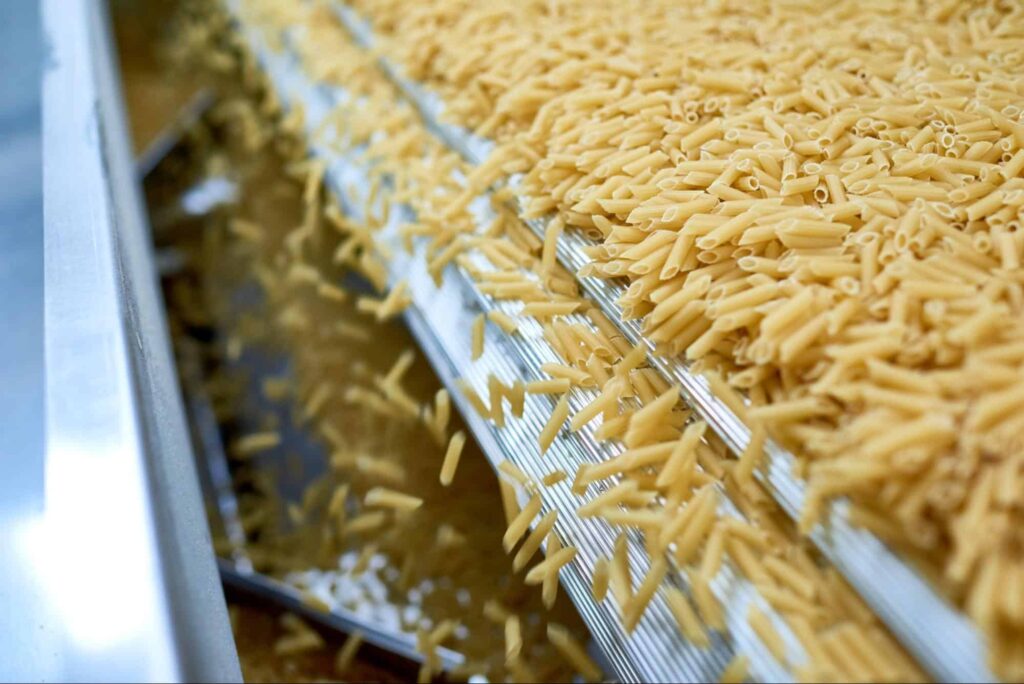In a landscape where industrial evolution is constant, staying ahead means recognizing the essential reasons for upgrading your conveyor system. Delve into this blog as we unravel the core factors steering this surge and explore how upgrading can propel your operations to new heights.
Explore All the Reasons for Upgrading Your Conveyor System
Our State Of Conveying Report reveals that 46% of industrial facilities (mainly in the food processing industry) are planning on updating or replacing their conveyor solutions in the next one to two years. Another 34% are planning on doing so in the next three to four years. But why are organizations making these changes?
There are many reasons, but most fall into the following categories: capacity, maintenance and repair, energy efficiency, material degradation, and the overall cost to operate. In fact, most of the participants in our survey (64%) highlighted maintenance issues as the primary reason they were looking to upgrade their material handling system. Below, we outline the top reasons you may need to upgrade your conveyor system based on our findings.
#1 Capacity Needs Have Changed
Most, if not all, business owners want their businesses to grow. Growth is good for the bottom line, and it’s also good for employee morale. As businesses expand, their production needs increase, which often means that the capacity of their industrial conveyor systems becomes strained.
If your conveyor belt system is no longer able to keep up with demand, then it’s time for an upgrade. 21% of industry professionals in our survey revealed that an insufficient volume per hour output was one of the top reasons they were looking to update or replace their conveyors.
How Do You Know When Your Automated Conveyor System Can No Longer Keep Up?
As demands evolve and production scales, manufacturing conveyor systems have to keep up, too. Let’s look at the signs that indicate your system can no longer keep up:
- Your conveyor is running at or near capacity all the time,
- You’re adding new product lines or increasing production of existing lines,
- Your product mix has changed and now includes heavier or larger items,
- You’re getting more customer orders, but throughput has not increased,
- You’re experiencing more downtime due to conveyor bottlenecks or similar material flow issues.
A new conveyor manufacturing system with a higher capacity can eliminate these issues and help you reach your new production goals. You may even seek out custom conveyor technologies built just for the needs of your production.

#2 Maintenance and Repair Costs Are Too High
Maintenance issues seem to be the number one reason why businesses are looking to upgrade their conveyor belt systems. And it’s no wonder – frequent breakdowns and unplanned downtime can cost your business dearly in terms of both money and time.
If regular maintenance and repair costs are eating into your profits, it may be time for an upgrade. If you’re frequently replacing parts or entire sections of your conveyor, that’s also a sign that it’s time for an upgrade. Newer models of modern conveyors are often designed with better accessibility, making them easier and less costly to maintain.
Automated conveyor systems, in particular, can help you save on conveyor maintenance costs. These systems are much more reliable than traditional conveyor equipment and often come with predictive maintenance features that can help you identify potential issues before they cause a breakdown.
#3 More Energy-Efficient Features
Energy efficiency has been the main focus of many businesses in recent years, and for a good reason. Not only can it lead to drastic cost savings, but in these times of increased environmental awareness, it’s also the right thing to do for the planet.
At the start of 2022, 2,392 global corporations have committed to science-based targets to reduce their CO2 emissions. If you’re looking to reduce your carbon footprint and save on energy costs, upgrading your conveyor system is a great place to start. Newer or different types of conveyors can offer a variety of energy-saving features, such as:
- Variable speed drives,
- Low-friction rollers or bearings,
- Energy-efficient motors,
- Automation.
Look into the energy-saving features available for the type of conveyor solution you’re interested in, and make sure to factor the savings into your ROI calculations.

#4 Conveyed Materials Are Degrading
Material degradation is a common issue for businesses that convey powders, granules, food ingredients, and other fragile materials. The constant friction and abrasion of these types of materials can cause them to break down into smaller pieces or dust over time.
Not only does this result in an inferior product, but it can also cause problems with your automatic conveyor system. Smaller pieces of material are more likely to become lodged in the conveyor’s nooks and crannies and cause jams.
If you’re noticing an increase in product degradation or conveyor jams, it may be time for an upgrade. Features that can help reduce product degradation include:
- Smooth, rounded edges on rollers and pulleys,
- Wear-resistant coatings,
- Enclosed conveyors to keep out dust and debris.
Choosing One of the Conveyor Systems Manufacturers
In the case of material integrity (or lack thereof), it is important to look beyond small features and ask yourself the big question: Is the type of conveyor I’m using the best for my product? If not, it may be time to switch to a different kind of conveyor.
For example, nut production facilities largely use pneumatic conveying to move their product from one stage of production to the next. But pneumatic conveyors, with their high speeds and air currents, often cause nuts to break apart. In these cases, it may be best to switch to a slower, gentler conveying method, such as a cable and disc conveyor system.
So, knowing your product and understanding how different types of conveyors (e.g., roller conveyor, bucket elevator, gravity conveyor, chain conveyor, or similar) will affect it is crucial when deciding whether or not to upgrade your system.
#5 Overall Operating Costs Are Too High
There is no doubt that installing a new conveyor system is a significant investment. Many decision-makers make a mistake when calculating the return on investment (ROI) of new material handling equipment by only looking at the purchase price.
While the upfront cost is certainly important, it’s not the only factor that should be considered when calculating ROI. You also need to take into account factors such as:
- Operating costs,
- Energy costs,
- Maintenance costs,
- Downtime costs.
If the total cost of ownership (TCO) of your conveyor system is too high, it may be time for an upgrade. Newer conveyor systems often come with features that can help reduce TCO, such as:
- Lower energy consumption,
- Fewer moving parts (and thus, less maintenance),
- Longer lifespan,
- Improved reliability and uptime.
When calculating ROI, be sure to factor in all the costs associated with owning and operating your conveying system. Otherwise, you may make a decision based on incomplete information.

Beyond the Basics – Additional Considerations for Conveyor System Upgrades
The five reasons above are some of the most common reasons production facilities decide to upgrade their conveyor systems. But there are other reasons as well. For example, you may need to upgrade your system if:
- You need a more versatile conveyor engineering,
- Your current system doesn’t meet safety standards,
- Your conveyor system is too old and outdated,
- There is a new type of technology or material that you want to be able to use,
- You want to increase the available floor space.
An important thing to keep in mind is that this isn’t a personal decision. In other words, don’t upgrade your conveyor system simply because you’re tired of the old one or you think it would be “cool” to have a new one. Trends come and go, but a conveying system is a long-term commitment.
Be sure to sit down with your team and carefully consider all the factors involved before making a decision. Upgrading your tubular conveyor system is a big investment, so you want to be sure you’re doing it for the right reasons.
Navigate the Path to Conveyor Excellence With Cablevey Conveyors
Consider all the challenges you’re facing right now and all the reasons for upgrading your conveying technologies. It’s important to sit down with your team and carefully go through all the factors before making a final decision. Upgrading to a tubular conveying system is a long-term investment, so you want to be sure you’re doing it for the right reasons. Once you’ve decided to upgrade your system, be sure to research and choose a reputable conveyor manufacturer with experience in designing and installing the type of system you need. If you desire further insights on conveyors and the selection of an optimal conveyor system for your business, feel free to reach out to us at Cablevey. Our team is eager to assist and address any inquiries you may have.






